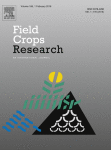Ver ítem
- xmlui.general.dspace_homeCentros Regionales y EEAsCentro Regional Santa FeEEA ReconquistaArtículos científicosxmlui.ArtifactBrowser.ItemViewer.trail
- Inicio
- Centros Regionales y EEAs
- Centro Regional Santa Fe
- EEA Reconquista
- Artículos científicos
- Ver ítem
Oil quality of maize and soybean genotypes with increased oleic acid percentage as affected by intercepted solar radiation and temperature
Resumen
Oil fatty acid composition of traditional genotypes of several crops including maize and soybean is affected by intercepted solar radiation per plant and temperature during grain filling. The effect of intercepted radiation on oil fatty acid composition of genotypes with increased oleic acid percentage of maize and soybean is unknown. Likewise, on such kind of maize genotypes, no studies have been performed about the effect of temperature on the oleic
[ver mas...]
Oil fatty acid composition of traditional genotypes of several crops including maize and soybean is affected by intercepted solar radiation per plant and temperature during grain filling. The effect of intercepted radiation on oil fatty acid composition of genotypes with increased oleic acid percentage of maize and soybean is unknown. Likewise, on such kind of maize genotypes, no studies have been performed about the effect of temperature on the oleic acid percentage. The objective of this work was to investigate and model the effect of intercepted solar radiation per plant and daily mean temperature during grain filling on the oleic acid percentage in the oil of maize and soybean genotypes with increased oleic acid grown under non limiting conditions. Field experiments were conducted in Balcarce and Córdoba in two growing seasons. An experiment with maize genotypes was also conducted in two sowing dates in Pergamino. The effect of intercepted solar radiation during grain filling on oil fatty acid composition was studied by shading and thinning plants. To evaluate the effect of daily mean temperature, plants were exposed to different temperatures during grain filling in two experiments performed in greenhouse and growth chambers. At harvest oil fatty acid composition was determined by gas–liquid chromatography. Intercepted solar radiation per plant or temperature increased the oleic acid percentage between 9 and 30 percentage points depending on the species and genotype. In both species, genotypes with increased oleic acid percentage presented a higher sensitivity of oleic acid percentage to variations in intercepted solar radiation than traditional ones. The effect of temperature on oil fatty acid composition was also higher in maize genotypes with increased oleic acid percentage than in the traditional one of the same species. In soybean, the sensitivity of oleic acid percentage to temperature was higher in one genotype and lower in the other as compared to the traditional one. Oleic acid percentage was linearly related to DMT but curvilinearly related to ISR per plant, reaching a maximum concentration of this fatty acid at high levels of irradiance. For both species, models that consider the additive effects of intercepted solar radiation and temperature were established. Predictions of the models were validated with data from six field independent experiments. The models adequately estimated (r2 ≥ 0.65) the oleic acid percentage of these genotypes grown under different temperatures and ISR per plant during grain filling from these experiments. These results could help to identify crop management practices (e.g. sowing dates, locations, sowing density), in the view to obtain a given oil quality when growing maize and soybean with increased oleic acid percentage.
[Cerrar]

Autor
Zuil, Sebastian;
Izquierdo, Natalia Gabriela;
Luján, Jorge S.;
Cantarero, Marcelo G.;
Aguirrezábal, Luis Adolfo Nazareno;
Fuente
Field Crops Research 127 : 203-214 (February 2012)
Fecha
2012-02-27
Editorial
Elsevier
ISSN
0378-4290
1872-6852
1872-6852
Formato
pdf
Tipo de documento
artículo
Palabras Claves
Derechos de acceso
Restringido
 Excepto donde se diga explicitamente, este item se publica bajo la siguiente descripción: Creative Commons Attribution-NonCommercial-ShareAlike 2.5 Unported (CC BY-NC-SA 2.5)
Excepto donde se diga explicitamente, este item se publica bajo la siguiente descripción: Creative Commons Attribution-NonCommercial-ShareAlike 2.5 Unported (CC BY-NC-SA 2.5)

